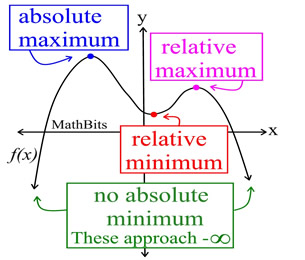Maximum and Minimum Value
Quadratic Functions:
- either have a maximum value or minimum value. It depends on how the function opens up.
- if the graph opens upward the function has a minimum value.
-if the graph opens downward the function has a maximum value.

Relative Maximum and Relative Minimum
Cubic Functions:
- do not have neither maximum or minimum value
- but they may have relative maximum or relative minimum value

Absolute Minimum and Maximum Values
Quartic Functions:
- either have an absolute maximum or an absolute minimum value
- within intervals of the function, they may also have relative maximum or relative minimum value.

Multiplicity of a Zero
- Multiplicity can be thought as "How many times does the solution appears in the original equation"
. For example, in the polynomial function f(x) = (x – 3)^4(x – 5)(x – 8)^2, the zero 3 has multiplicity 4, 5 has multiplicity 1, and 8 has multiplicity 2. Although this polynomial has only three zeros, we say that it has seven zeros counting multiplicity.
- If a graph has real zeros of odd multiplicity the function will cross the x-axis
- If a graph has real zeros of even multiplicity the function will bounce off the x-axis

example:
f(x) = (2x+1)^2 (x-1)
- at x = -1/2 (zero of even multiplicity), the sign of the function does not change and it bounces off the x- axis
- at x = 1 (zero of odd multiplicity) the sign changes and the function crosses the x- axis
GOOD LUCK ON THE TEST!!

No comments:
Post a Comment